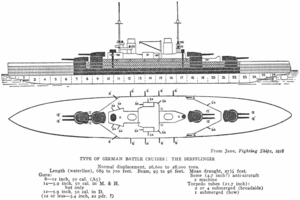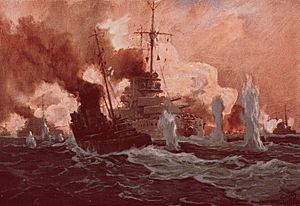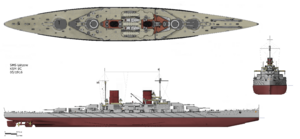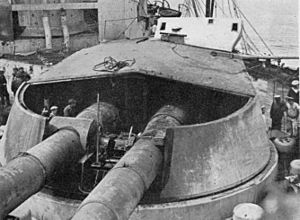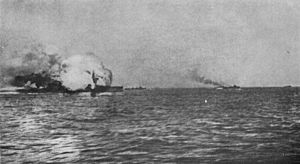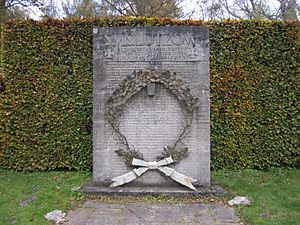SMS Lützow facts for kids
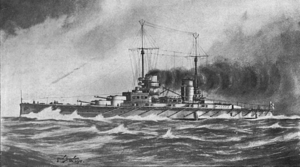
Illustration of Lützow
|
|
Quick facts for kids History |
|
|---|---|
| Name | Lützow |
| Namesake | Ludwig Adolf Wilhelm von Lützow |
| Ordered | 1912–1913 Naval Program |
| Builder | Schichau-Werke, Danzig |
| Laid down | 15 May 1912 |
| Launched | 29 November 1913 |
| Commissioned |
|
| Fate | Sunk at the Battle of Jutland, 1 June 1916 |
| Notes | Designated war grave |
| General characteristics | |
| Class and type | Derfflinger-class battlecruiser |
| Displacement | 26,741 t (26,319 long tons; 29,477 short tons) design load |
| Length | 210.40 m (690 ft 3 in) |
| Beam | 29 m (95 ft 2 in) |
| Draft | 9.20 m (30 ft 2 in) |
| Installed power |
|
| Propulsion |
|
| Speed | 26.4 knots (48.9 km/h; 30.4 mph) |
| Range | 5,600 nmi (10,400 km; 6,400 mi) at 14 knots (26 km/h; 16 mph) |
| Complement | 44 officers, 1,068 men |
| Armament |
|
| Armor |
|
SMS Lützow was a powerful warship called a battlecruiser. She was built for the German Imperial Navy before World War I. Lützow was launched in 1913 but wasn't fully ready until 1916. She was a sister ship to Derfflinger, meaning they were very similar.
Lützow was named after a famous Prussian general, Ludwig Adolf Wilhelm von Lützow. She joined the fleet in March 1916, so she didn't see much action early in the war. Her first big mission was bombing the British towns of Yarmouth and Lowestoft in April 1916.
One month later, Lützow played a major role in the Battle of Jutland, a huge naval battle. During this fight, she sank the British battlecruiser HMS Invincible. However, Lützow was also badly damaged. She was hit many times and started taking on a lot of water. Her crew had to leave the ship, and she was later sunk by a German torpedo boat to prevent her from falling into enemy hands. Today, Lützow is considered a war grave at the bottom of the sea.
Contents
Ship Design and Features
The Derfflinger class, which Lützow belonged to, was designed around 1910. Naval leaders decided their new battlecruisers needed bigger guns. They chose 30.5 cm (12 inch) guns instead of the older 28 cm (11 inch) ones. To save money, they used eight guns instead of ten, but arranged them better. This meant the guns could fire over each other, which was more effective.
Lützow was about 210.4 m (690 ft 3 in) long and 29 m (95 ft 2 in) wide. She weighed about 26,741 t (26,319 long tons) when fully loaded. Four powerful steam turbines powered the ship, driving four propellers. These engines gave Lützow a top speed of 26.4 knots (48.9 km/h; 30.4 mph) (about 49 km/h or 30 mph). Her crew included 44 officers and over 1,000 sailors.
Weapons and Protection
Lützow had eight 30.5 cm (12 inch) main guns. These were placed in four gun turrets, two at the front and two at the back. She also had fourteen 15 cm (5.9 inch) guns for smaller targets. For defense against aircraft, she carried eight 8.8 cm (3.5 inch) anti-aircraft guns. She also had four 60 cm (24 inch) torpedo tubes built into her hull, below the water.
To protect the ship, Lützow had thick armor up to 300 mm (11.8 in) (about 12 inches) thick. This armor protected important areas like the ammunition storage and engines. Her deck armor was between 30 to 80 mm (1.2 to 3.1 in) (1.2 to 3.1 inches) thick. The gun turrets had 270 mm (10.6 in) (10.6 inches) of armor. The command center, called the conning tower, had 300 mm (12 inches) thick walls.
Ship's Service in World War I
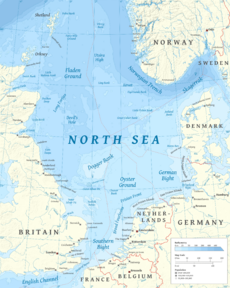
Lützow was built in Danzig, Germany. Her construction started in May 1912, and she was launched in November 1913. She began her sea trials in August 1915. During these tests, her engine was damaged, so repairs kept her from joining the main battlecruiser group until March 1916.
Her first and only commander was Captain Victor Harder. Lützow joined the High Seas Fleet for a few patrols in the North Sea. These patrols were meant to find British warships, but they didn't find any.
Bombing Yarmouth and Lowestoft
Lützow's first big mission was to bomb the British coastal towns of Yarmouth and Lowestoft. This happened on April 24–25, 1916. The German battlecruisers, including Lützow, left their base with support ships. The British knew about the attack because they intercepted German radio signals.
On the way, Seydlitz, another German battlecruiser, hit a mine. This caused a large hole in her hull. The commander of the German force, Admiral Boedicker, moved his flag from Seydlitz to Lützow.
The German ships reached Lowestoft early on April 25. They fired their guns at the town, destroying two shore batteries and causing other damage. Then, they turned north towards Yarmouth. Visibility was poor, so they only fired a few shots there. On their way back, they met British light cruisers and destroyers. The German ships opened fire, damaging the British cruiser Conquest. However, reports of British submarines made the Germans break off the chase and head back to Germany.
The Battle of Jutland
The Battle of Jutland was the largest naval battle of World War I. It took place on May 31 – June 1, 1916. Lützow was the lead ship of the German battlecruiser group, commanded by Admiral Hipper. The German fleet aimed to lure out and destroy part of the British fleet.
First Shots Fired
Around 4:00 PM, the German battlecruisers met the British 1st Battlecruiser Squadron. Lützow was the first German ship to fire, aiming at the British flagship, Lion. The British ships also fired, but their first shots missed.
Lützow hit Lion twice early in the battle. One of these hits was very important. A 30.5 cm shell from Lützow hit Lion's "Q" turret. It caused a fire and nearly blew up the ship. The turret commander, Major Francis Harvey, bravely ordered the magazine to be flooded with water, which saved the ship.
Soon after, another British battlecruiser, Indefatigable, was hit by shells from Von der Tann and exploded. Lützow continued to hit Lion, causing more damage. In the first 19 minutes of the battle, Lützow hit Lion six times.
Later, the British battleship Queen Mary was hit by other German ships and exploded. Both sides then launched torpedo attacks, but none hit Lützow. She did hit Lion again, causing a fire in her rear guns.
Fleets Clash
Around 6:00 PM, the main German battle fleet arrived and joined the fight. Lützow was hit by a large 15-inch shell from a British battleship. She was hit several more times as the battle continued. Her wireless transmitters were damaged, so she could only communicate using searchlights.
Around 7:00 PM, the German cruiser Wiesbaden was badly damaged. The German battlecruisers turned to help her. British destroyers tried to launch torpedoes at Lützow, but they missed. Lützow fired back, hitting the destroyer Onslow three times.
Then, the German ships spotted the British armored cruiser Defence. Lützow and other German ships fired on Defence. In less than five minutes, Defence was hit many times. Her ammunition magazines exploded, and the ship was destroyed.
While Lützow was focused on Defence, Lion hit Lützow twice, causing a serious fire. Soon after, the British 3rd Battlecruiser Squadron joined the fight. Their lead ship, Invincible, spotted Lützow and Derfflinger. Invincible hit Lützow eight times, mostly in her front section. These hits caused a lot of flooding, which would eventually sink the ship. In return, Lützow and Derfflinger focused their fire on Invincible. At 7:33 PM, Lützow hit Invincible's center turret, causing her magazine to explode. Invincible disappeared in a huge explosion. After this, Lützow was no longer under fire from British battlecruisers, but she was taking on a lot of water.
Lützow Retreats and Sinks
As night fell, the German fleet began to retreat. Lützow had lost speed and couldn't keep up. She tried to move away from the British ships. By 8:00 PM, water had reached the ammunition storage for her front guns.
Admiral Hipper and his staff left Lützow and moved to another ship. Torpedo boats laid a smoke screen to hide Lützow from the British. But at 8:15 PM, Lützow was hit by four more heavy shells. One hit her front gun turret, damaging it. Lützow fired her last shot at 8:45 PM, then was hidden by the smoke.
As the night continued, Lützow was sinking deeper. Water was pouring into the ship, especially in the front. By midnight, there was still hope she could make it back to port. But by 1:00 AM, there was too much water for the pumps to handle. Water flooded the engine rooms, forcing the crew to work by candlelight.
By 1:30 AM, Lützow was so low in the water that the front boiler room began to flood. Almost all the front parts of the ship were filled with water. The crew tried to patch the holes, but the ship was sinking too fast. Her front was so submerged that her propellers were partly out of the water.
By 2:20 AM, an estimated 8,000 tons of water were in the ship. Captain Harder ordered the crew to abandon ship. Torpedo boats came alongside to rescue the sailors. Six men were trapped in the bow and could not be saved. By 2:45 AM, Lützow was submerged up to her bridge. The torpedo boat G38 fired two torpedoes into her, and two minutes later, she sank beneath the waves.
Lützow was about 60 km (37 mi) northwest of Horns Reef when she was sunk. During the battle, she fired many shells and was hit 24 times by British heavy guns. 115 of her crew were killed, and 50 were wounded.
In 2015, a British survey ship, HMS Echo, found the wreck of Lützow on the seabed. She was about eight miles from where she was last recorded. Echo took sonar images of the wreck, making sure her final resting place is recognized as a war grave.
See also
- German cruiser Lützow, for other warships named Lützow


